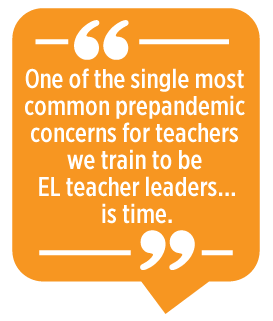|
 In our book, Teacher
Leadership for School-Wide English Learning, we present
the critical role that nonevaluative peer observation plays in English as a
second language (ESL) teacher leadership. Not only has the global pandemic
dramatically shifted the way that teachers deliver instruction; it has also
shifted the responsibilities of ESL teachers in schools. Little did we know
when we were writing this book that ESL teacher leadership was about to become essential in schools that serve ELs.
In our book, Teacher
Leadership for School-Wide English Learning, we present
the critical role that nonevaluative peer observation plays in English as a
second language (ESL) teacher leadership. Not only has the global pandemic
dramatically shifted the way that teachers deliver instruction; it has also
shifted the responsibilities of ESL teachers in schools. Little did we know
when we were writing this book that ESL teacher leadership was about to become essential in schools that serve ELs.
As we learn
more about the effects of Emergency Remote Distance Learning (ERDL) on all
learners, but particularly English learners (ELs), it is clear that distance
learning has had a negative impact. This year has been a balancing act between
learning and safety—as education equity and COVID-19 outcomes both put our
immigrant communities at a disadvantage. In this challenging environment, EL
teacher leaders have developed creative ways to teach and lead in the distance
learning environment that we can carry forward post pandemic.
 We have
trained almost 300 EL teacher leaders in Minnesota and Oregon. The school-wide
English learning (SWEL) model for EL teacher leadership provides a framework
for how schools can improve instruction for ELs by positioning ESL teachers as
site-based experts and teacher trainers. (Read more about the SWEL model in our
earlier article, “ESL
Teacher Leadership: Delivering Professional Development.”) In our
work with the SWEL model, we’ve learned some key lessons that influence how
nonevaluative peer coaching and professional development support can be
delivered by ESL teachers. One of the single most common prepandemic concerns
for the teachers we train to be EL teacher leaders, or SWEL coaches, is time.
The research on teacher leadership bears this out as a significant roadblock to
positioning practicing teachers as leaders in their schools. We have
trained almost 300 EL teacher leaders in Minnesota and Oregon. The school-wide
English learning (SWEL) model for EL teacher leadership provides a framework
for how schools can improve instruction for ELs by positioning ESL teachers as
site-based experts and teacher trainers. (Read more about the SWEL model in our
earlier article, “ESL
Teacher Leadership: Delivering Professional Development.”) In our
work with the SWEL model, we’ve learned some key lessons that influence how
nonevaluative peer coaching and professional development support can be
delivered by ESL teachers. One of the single most common prepandemic concerns
for the teachers we train to be EL teacher leaders, or SWEL coaches, is time.
The research on teacher leadership bears this out as a significant roadblock to
positioning practicing teachers as leaders in their schools.
Teacher
leaders who retain classroom duties worry about where they will find time to
support their colleagues’ efforts to improve instruction for ELs in their
general education classrooms. Despite our work with administrators to ensure
that there is time carved out in the EL teacher’s schedule for this work, it is
not always possible. School closures related to COVID-19 forced us to think
creatively about how SWEL coaches can continue to serve in their roles, and
many of the new methods for providing this support can be carried forward as a
measure to manage time efficiently. These methods include using video for
teacher observations and expanding our understanding of what is
“observable.”
Using Video for Teacher
Observations
Prepandemic,
videotaping lessons and sharing those videos for a variety of purposes,
including observations and reflective peer conversations, was relatively
uncommon. It appears that the synchronous distance learning classroom changed
this in schools across the country. Teachers in all content areas are becoming
practiced in recording the live lessons that they deliver to students, and we
are collectively growing more comfortable with seeing ourselves on screen.
SWEL coaches
have been able to conduct nonevaluative peer observations in the distance
learning environment using these recordings of live class sessions, which means
that they can work with colleagues with whom they might otherwise have
conflicting schedules that would make a live observation difficult or
impossible. In other words, both teachers involved—the SWEL coach and the
general education teacher—are able to participate on their own time rather than
try to shuffle around their schedules, cancel small group instruction for ELs,
or give up their prep time to do an observation.
In addition,
a single videotaped lesson can be used to serve multiple purposes. A SWEL coach
might use the videotaped lesson from one of their colleagues to observe using
the SWEL
Support Tool, which focuses on effective instruction for ELs, while
the principal might use that same videotape for one of the required annual
observations. Perhaps the general education teacher is assembling a portfolio
for National Board Certification or another similar endeavor, and the same
videotape can be added to those efforts. Underlying all of these options are
two clear benefits: efficient use of time and teacher agency. Videotaped
lessons can serve multiple professional development purposes, while a live
lesson usually only serves one.
As time is
such a limited commodity for teachers, it stands to reason that video continues
to be utilized as a professional learning tool postpandemic, especially given
our newfound comfort with using it. Teacher agency plays a role, too, in that
the teacher doing the videotaping is able to choose when and how to do the
recording. This may help to alleviate some of the stress that comes with having
someone in the “back of the room” watching.
Expanding Our
Understanding of What Is “Observable”
Not all
schools have offered live or synchronous class sessions to their students
during ERDL, online schooling, and hybrid instruction. Teachers we have
interviewed for a related study reported that their schools and districts felt
that expecting students to attend live sessions was inequitable, as there were
varying degrees of access to technology among the students and their families.
This was particularly the case in the spring of 2020, when teachers had very
little time to transition from in-person teaching to ERDL.

If
synchronous teaching is not being delivered, then videotaping a lesson is
rendered impossible. So, what is a SWEL coach going to do to ensure that their
colleagues know how to support ELs in the remote environment? We have learned
that there are a number of ways to serve as a SWEL coach in these situations,
so long as we are willing to reframe what we consider observable as we are
using the SWEL Support Tool. Some of the methods the teachers we work with have
discovered follow.
- “Observing” the lesson plan. In an
effort to figure out how SWEL coaches could still be supportive when their
schools were only offering asynchronous instruction to students, it became
clear that they could play an important role in the planning for asynchronous
instruction. SWEL coaches and their general education colleagues shared their
lesson plans, which stood in for a live observation using the SWEL Support
Tool. It turns out that this is not only an efficient workaround, because it is
done through shared digital documents rather than in-person observations or
coplanning, but it also provides a new vantage point for SWEL coaches to
support their colleagues’ instruction of ELs in the general education classroom before the instruction takes place. In many cases, SWEL
coaches reported that more colleagues than ever before had sought out their
advice to plan lessons that were accessible to ELs. While “observing” the
lesson plan was meant as a triaged measure to maintain the efforts of SWEL
coaches, it turns out to be a popular method that can be carried beyond
distance learning.
- Supporting the design of the
student-facing learning platform, such as Schoology or Google
Classroom. Many teachers throughout K–12 are using learning management
systems to organize and deliver their content to students. SWEL coaches can
play a critical role in “observing” the structures and design of these systems
in an effort to ensure that the instructions are clear, there are visuals and
other scaffolds to support learning, and the content is differentiated in a way
that makes the content materials accessible to ELs. Given that many schools
were already using learning management systems like Schoology and Google
Classroom to support in-person instruction, it stands to reason that
schools will continue to do so in the post-COVID-19 environment. SWEL coaches can
continue to play an important role in ensuring that the digital content
delivered to students meets the needs of ELs.
- Reviewing teacher-created
materials. Though some teachers have been creating digitized
versions of their instructional materials for years, COVID-19 has forced anyone
who was not doing so already to transition to online materials creation. As
such, teacher-created materials—including (but definitely not limited to!) the
slide decks used in prerecorded instructional videos; assessments, such as
quizzes and tests; anchor texts; and worksheets—are great options for SWEL
coach review and support.
- Delivering prerecorded,
asynchronous professional development related to supporting ELs in the general
education classroom. SWEL coaches are taking advantage of the
same tools they are using to teach, like Screencast-O-Matic
and FlipGrid, to
offer self-paced professional development for their colleagues using both
SWEL-created materials and their own resources. Allowing teachers to
participate in professional development at their convenience turns out to be a
terrific time saver that helps to increase participation. There is no reason to
discontinue this method of professional development delivery post-COVID-19 if it
is proving effective during ERDL and hybrid schooling.
Though there will surely be a collective
sigh of relief when we are able to return to schools in person safely, there
are many ways in which SWEL coaches and other EL teacher leaders will be able
to streamline and improve instruction for ELs because of what we learned during
COVID-19–related distance learning. These new ways of supporting teacher
colearning are time efficient, have a broad reach, and support teacher choice
and agency in their professional learning. They are worthy of maintaining in a
postpandemic world.
Reference
Benegas, M.,
& Stolpestad, A. (2020). Teacher leadership for school-wide
English learning. TESOL International Association.
Michelle Benegas, PhD, is an assistant professor and faculty lead of the English Learners in the Mainstream (ELM) Project at Hamline University. In her work with teachers and schools, she promotes a model in which ESL teachers serve as site-based experts and coaches to their general education colleagues. Her research interests include ESL teacher leadership, teacher leader identity, and systemic approaches to improving EL services.
Amy Stolpestad, EdD, currently serves as the director of The ELM Project and also consults with local, regional, state, and higher education institutions. Stolpestad is a Minnesota licensed K–12 ESL teacher and experienced teacher educator. Her research interests include teacher leadership, instructional coaching, teacher identity, and organizational change management. |